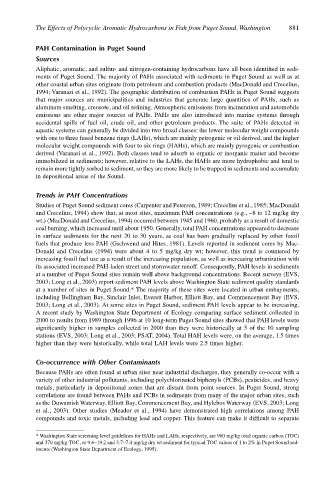Page 901 - The Toxicology of Fishes
P. 901
The Effects of Polycyclic Aromatic Hydrocarbons in Fish from Puget Sound, Washington 881
PAH Contamination in Puget Sound
Sources
Aliphatic, aromatic, and sulfur- and nitrogen-containing hydrocarbons have all been identified in sedi-
ments of Puget Sound. The majority of PAHs associated with sediments in Puget Sound as well as at
other coastal urban sites originate from petroleum and combustion products (MacDonald and Crecelius,
1994; Varanasi et al., 1992). The geographic distribution of combustion PAHs in Puget Sound suggests
that major sources are municipalities and industries that generate large quantities of PAHs, such as
aluminum smelting, creosote, and oil refining. Atmospheric emissions from incineration and automobile
emissions are other major sources of PAHs. PAHs are also introduced into marine systems through
accidental spills of fuel oil, crude oil, and other petroleum products. The suite of PAHs detected in
aquatic systems can generally be divided into two broad classes: the lower molecular weight compounds
with one to three fused benzene rings (LAHs), which are mainly petrogenic or oil derived, and the higher
molecular weight compounds with four to six rings (HAHs), which are mainly pyrogenic or combustion
derived (Varanasi et al., 1992). Both classes tend to adsorb to organic or inorganic matter and become
immobilized in sediments; however, relative to the LAHs, the HAHs are more hydrophobic and tend to
remain more tightly sorbed to sediment, so they are more likely to be trapped in sediments and accumulate
in depositional areas of the Sound.
Trends in PAH Concentrations
Studies of Puget Sound sediment cores (Carpenter and Peterson, 1989; Crecelius et al., 1985; MacDonald
and Crecelius, 1994) show that, at most sites, maximum PAH concentrations (e.g., ~8 to 12 mg/kg dry
wt.) (MacDonald and Crecelius, 1994) occurred between 1945 and 1960, probably as a result of domestic
coal burning, which increased until about 1950. Generally, total PAH concentrations appeared to decrease
in surface sediments for the next 20 to 30 years, as coal has been gradually replaced by other fossil
fuels that produce less PAH (Gschwend and Hites, 1981). Levels reported in sediment cores by Mac-
Donald and Crecelius (1994) were about 4 to 5 mg/kg dry wt; however, this trend is countered by
increasing fossil fuel use as a result of the increasing population, as well as increasing urbanization with
its associated increased PAH-laden street and stormwater runoff. Consequently, PAH levels in sediments
at a number of Puget Sound sites remain well above background concentrations. Recent surveys (EVS,
2003; Long et al., 2003) report sediment PAH levels above Washington State sediment quality standards
at a number of sites in Puget Sound.* The majority of these sites were located in urban embayments,
including Bellingham Bay, Sinclair Inlet, Everett Harbor, Elliott Bay, and Commencement Bay (EVS,
2003; Long et al., 2003). At some sites in Puget Sound, sediment PAH levels appear to be increasing.
A recent study by Washington State Department of Ecology comparing surface sediment collected in
2000 to results from 1989 through 1996 at 10 long-term Puget Sound sites showed that PAH levels were
significantly higher in samples collected in 2000 than they were historically at 5 of the 10 sampling
stations (EVS, 2003; Long et al., 2003; PSAT, 2004). Total HAH levels were, on the average, 1.5 times
higher than they were historically, while total LAH levels were 2.5 times higher.
Co-occurrence with Other Contaminants
Because PAHs are often found at urban sites near industrial discharges, they generally co-occur with a
variety of other industrial pollutants, including polychlorinated biphenyls (PCBs), pesticides, and heavy
metals, particularly in depositional zones that are distant from point sources. In Puget Sound, strong
correlations are found between PAHs and PCBs in sediments from many of the major urban sites, such
as the Duwamish Waterway, Elliott Bay, Commencement Bay, and Hylebos Waterway (EVS, 2003; Long
et al., 2003). Other studies (Meador et al., 1994) have demonstrated high correlations among PAH
compounds and toxic metals, including lead and copper. This feature can make it difficult to separate
* Washington State screening level guidelines for HAHs and LAHs, respectively, are 960 mg/kg total organic carbon (TOC)
and 370 mg/kg TOC, or 9.6–19.2 and 3.7–7.4 mg/kg dry wt sediment for typical TOC values of 1 to 2% in Puget Sound sed-
iments (Washington State Department of Ecology, 1995).

